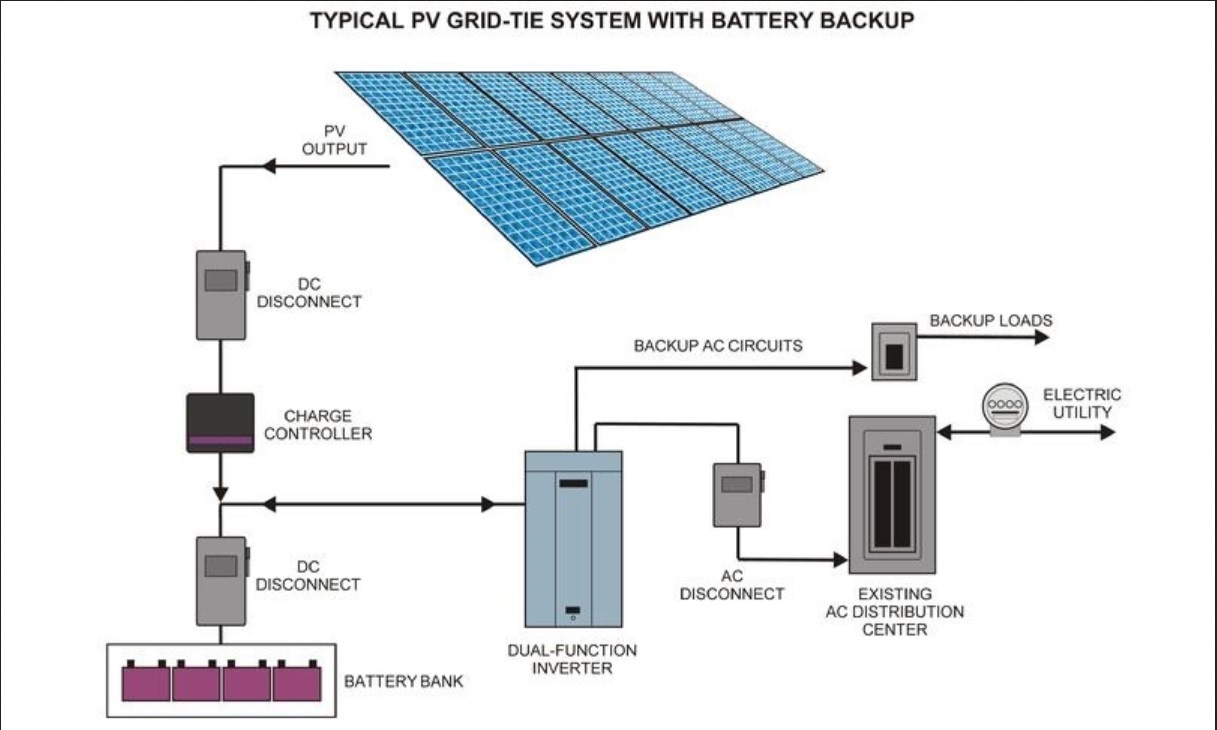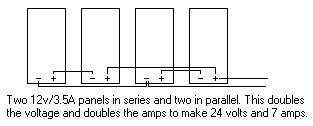

Event Horizon Solar & Wind Inc
Providing Solar and Wind power for
23 years
Email
9am to 5pm eastern.
| Home | Grid tie panels | Resources | Grid tie Info | Contact Us |
|
Producing electricity with solar
power
Components in a typical solar
power system
Solar panels charge the battery. The charge regulator insures proper charging of the battery. The battery provides DC voltage to the inverter, and the inverter converts the DC voltage to normal AC voltage.
|

|
Solar Panels
V x A = W
Since sunlight intensity varies throughout the day, we use the term "peak sun hours" as to smooth out these variations into a daily average. Early morning and late-in-the-day sunlight produces less power than does the mid-day sun. Naturally, cloud cover also affects power production. Each geographical region has an Average Peak Sun Hours per Day rating which compensates for regional weather conditions and latitude. See the section "Determining your solar power requirements" for your region's ratings.
If an average of 6 hours of peak sun per day is available in an area,
then a 60 watt panel produces an average 360 watt hours of power
per day: Series wiring refers to connecting the positive terminal of one panel to the negative terminal of another. The resulting voltage across the across the terminals of the combined panels is the sum of the voltage of the two individual panels, but the current remains constant for both panels. For example, two 12volt/3.5 amp panels wired in series produce 24 volts at 3.5 amps. Four series wired panels produce 48 volts at 3.5 amps. Parallel wiring refers to connecting positive terminals to positive terminals and negative to negative. The resulting voltage stays the same, but amperage becomes the sum of the number of panels. Two 12 volt/3.5 amp panels wired in parallel produce 12 volts at 7 amps. Four panels would produce 12 volts at 14 amps. Series/parallel wiring refers to combining both of the above - increasing volts and amps to achieve the desired system voltage as in 24 or 48 volt systems and desired amperage. The following diagram reflects this. In addition, the four panels below can then be wired in parallel to another four and so on to make a larger array. Most grid tie panels are series wired to increase voltage which makes wire size smaller and decreases the amount of wire in such systems.
|

We recommend you also review our page
Helpful
Solar Power Glossary which will provide useful terms.
|
Solar Charge Controller
Solar Battery
A battery in a solar power system needs sufficient amp hour capacity to supply needed power during the longest expected period "no sun" or extremely cloudy conditions. A lead-acid battery should be sized at least 20% larger than this amount. If there is a source of back-up power, such as a standby generator along with a battery charger, the battery bank does not have to be sized for worst case weather conditions. The size of the battery bank depends on the
storage capacity required, the maximum charge and discharge rates, and the
minimum temperature at which the batteries will be used. When planning a power
system, all of these factors are looked at, and the one requiring the largest
capacity will dictate battery size The inverter switches direct current (DC) back and forth to produce alternating current (AC). The resulting AC current is transformed, filtered to produce an acceptable output waveform. The more processing, the cleaner and quieter the output, but the lower the efficiency of the conversion. The goal becomes to produce a waveform that is acceptable to all loads without sacrificing too much power into the conversion process. Two basic inverter outputs designs are available, sine wave and modified sine wave. Most ac devices can use the modified sine wave but there are some notable exceptions. Laser printers which use triacs and/or silicon controlled rectifiers are damaged when provided mod-sine wave power. Motors and power supplies usually run warmer and less efficiently on mod-sine wave power. Items such as fans, amplifiers, and cheap fluorescent lights, give off an audible buzz on modified sine wave power. However, modified sine wave inverters make the conversion from DC to AC very efficiently and they are relatively inexpensive and can power many common electrical devices very effectively. Sine wave inverters can virtually operate anything. Your utility company provides sine wave power and a sine wave inverter is equal to or even better than utility supplied power. A sine wave inverter can "clean up" utility or generator supplied power because of its internal processing. All grid tie inverters are true sine wave inverters. Inverters are made with various internal features and many permit external equipment interface and almost all now include Wi-Fi and networking capability. Common internal features are internal battery chargers which can rapidly charge batteries when an AC source such as a generator or utility power is connected to the inverter's INPUT terminals. Auto-transfer switching is also a common internal feature which enables switching between different AC sources, or from utility power to inverter power for designated loads. Battery temperature compensation, internal relays to control loads, automatic remote generator starting/stopping and many other programmable features are available.
|
Please feel free to contact us for expert technical assistance.
 EVENT HORIZON SOLAR & WIND |
Copyright © 2023 Event Horizon Solar and Wind Inc. All rights reserved.